Video Kitten and Baby Owl Meet for the First Time and Their You Should Know
| Scottish Fold | |
|---|---|
 Lilac coloured adult Scottish Fold, displaying circular face, round eyes and forrard-folded ears | |
| Other names | Scot Fold |
| Origin | |
| Breed standards | |
| CFA | standard |
| TICA | standard |
| ACFA/CAA | standard |
| Notes | |
| Non recognised by FIFe and GCCF | |
| Domestic cat ( Felis catus ) | |
The Scottish Fold is a breed of domestic cat with a natural dominant gene mutation that affects cartilage throughout the body, causing the ears to "fold", bending forward and down towards the front end of the head, which gives the cat what is often described every bit an "owl-like" appearance.[one]

Lilac-colored Scottish Fold kitten
Originally called lop-eared or lops after the lop-eared rabbit, Scottish Fold became the breed'due south name in 1966.[ane] Depending on registries, longhaired Scottish Folds are varyingly known every bit Highland Fold, Scottish Fold Longhair, Longhair Fold and Coupari.
History [edit]
Origin [edit]


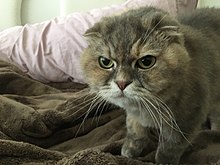
The original Scottish Fold was a white barn cat named Susie, who was found at a subcontract virtually Coupar Angus in Perthshire, Scotland, in 1961. Susie's ears had an unusual fold in their heart, making her resemble an owl. When Susie had kittens, two of them were born with folded ears, and one was acquired by William Ross, a neighbouring farmer and cat-fancier.[2] Ross registered the breed with the Governing Council of the True cat Fancy (GCCF) in the United kingdom of great britain and northern ireland in 1966 and started to brood Scottish Fold kittens with the help of geneticist Pat Turner.[3] The breeding program produced 76 kittens in the first three years—42 with folded ears and 34 with straight ears. The conclusion from this was that the ear mutation is due to a elementary ascendant cistron.[4]
Susie's only reproducing offspring was a female person Fold named Snooks who was likewise white; a second kitten was neutered before long later nativity. Three months after Snooks' nativity, Susie was killed by a car. All Scottish Fold cats share a common ancestry to Susie.
Acceptance [edit]
The breed was not accepted for showing in Europe and the GCCF withdrew registrations in 1971 due to crippling deformity of the limbs and tail in some cats and concerns near genetic difficulties and ear problems such as infection, mites, and deafness, but the Folds were exported to America and the breed continued to be established using crosses with British Shorthairs and American Shorthairs. Since the initial concerns were brought, the Fold breed has not had the mite and infection bug, though wax buildup in the ears may be greater than in other cats.[ane] The concerns well-nigh deformities may have been caused past osteochondrodysplasia, which causes abnormalities in bone and cartilage throughout the torso.
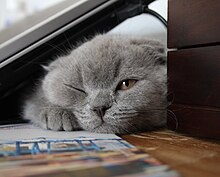
3 month-old Scottish Fold kitten
Popularity [edit]
The rare distinctive physical traits of the brood, combined with their reputation equally unusually loving companions, make Folds highly sought-after pets and Fold kittens typically cost considerably more than kittens of more than common breeds.[five] Scottish folds are also pop among celebrities, i of them existence American singer Taylor Swift, who has named her two Scottish fold cats after two well-known fictional characters – "Meredith Grey" and "Olivia Benson".[ citation needed ]
Characteristics [edit]

Lilac-colored Scottish Fold
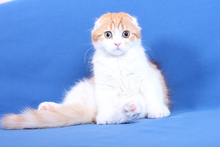
Scottish Fold longhair kitten
Ears [edit]
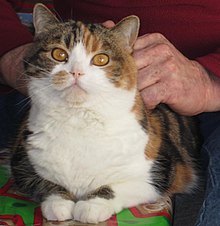
Scottish Fold with straight ears
Scottish Fold kittens that practise non develop folded ears are known every bit Scottish Straights.[1] The original cats just had one fold in their ears, but due to selective convenance, breeders have increased the fold to a double or triple pucker that causes the ear to lie totally flat confronting the head.[ commendation needed ]
The brood's distinctive folded ears are produced by an incompletely dominant cistron that affects the cartilage of the ears, causing the ears to fold forward and downwardly, giving a cap-similar appearance to the head. Smaller, tightly folded ears set in a cap-like fashion are preferred to a loose fold and larger ear. The large, circular eyes and rounded head, cheeks, and whisker pads add to the overall rounded advent. Despite the folded ears, folds however utilize their aural appendages to limited themselves—the ears hinge to listen, prevarication dorsum in acrimony and prick up when the treat pocketbook rustles.[5]
Torso [edit]
The Scottish Fold is a medium-sized cat, unremarkably ash in color. Males typically weigh four–half-dozen kg (8.viii–thirteen.ii lb), and females counterbalance two.7–four kg (6.0–8.eight lb). The Fold'south entire trunk structure, especially the head and face, is more often than not rounded, and the eyes large and round. The nose is short with a gentle curve, and the cat's trunk is well-rounded with a padded look and medium-to-curt legs. The head is domed at the height, and the neck very brusque. The broadly-spaced eyes give the Scottish Fold a "sugariness expression".[4]
Glaze [edit]
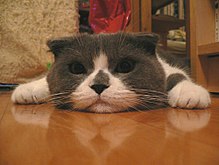
"Blue" and white Scottish Fold
Scottish Folds tin be either long- or short-haired, and they may take nearly whatever coat color or combination of colours (including white).[4] Shorthair Scottish Folds have thick and soft fur, with longhair Folds having longer and exceptionally dumbo fur around their upper thighs, toes, ears, and tail.[6]
Temperament [edit]
Scottish Folds, whether with folded ears or with normal ears, are typically good-natured and placid and adjust to other animals within a household extremely well. They tend to become very attached to their human caregivers and are by nature quite affectionate. Folds as well receive loftier marks for playfulness, grooming and intelligence. Scottish Folds like to be outdoors and enjoy outdoor games and activities. Loneliness is something they heavily dislike. It is too common for Scottish Folds to be stubborn.
Habits [edit]
Folds are also known for sleeping on their backs.[iv] Scottish Folds typically have soft voices and display a complex repertoire of meows and purrs not constitute in better-known breeds. Folds are also known for sitting with their legs stretched out and their paws on their abdomen. This position is chosen the "Buddha Position".[7]
Genetics [edit]
An early study suggested that the fold is inherited as an autosomal dominant trait.[8] A later study suggested an incomplete dominance.[9] A cat with folded ears may accept either 1 (heterozygous) or 2 copies (homozygous) of the dominant fold factor (Fd). A cat with normal ears should have two copies of the normal gene (fd).
| Homozygous fold | |||
|---|---|---|---|
| Fd | Fd | ||
| Homozygous fold | Fd | Fd Fd | Fd Fd |
| Fd | Fd Fd | Fd Fd | |
| Heterozygous fold | |||
|---|---|---|---|
| Fd | fd | ||
| Homozygous fold | Fd | Fd Fd | Fd fd |
| Fd | Fd Fd | fd Fd | |
| Straight-eared | |||
|---|---|---|---|
| fd | fd | ||
| Homozygous fold | Fd | Fd fd | Fd fd |
| Fd | Fd fd | Fd fd | |
Mating a homozygous fold with any true cat will produce all folds, but because homozygous folds are prone to astringent health problems, breeding for them is generally considered unethical. A homozygous to normal mating will produce just heterozygous folds but presumably in ethical breeding programs, there will be no homozygous cats bachelor to breed from.
| Straight-eared | |||
|---|---|---|---|
| fd | fd | ||
| Heterozygous fold | Fd | Fd fd | Fd fd |
| fd | fd fd | fd fd | |
The only generally accustomed breeding gives a 50% hazard of producing heterozygous folds and 50% chance of producing progeny with normal genes.
| Heterozygous fold | |||
|---|---|---|---|
| Fd | fd | ||
| Heterozygous fold | Fd | Fd Fd | Fd fd |
| fd | fd Fd | fd fd | |
At that place is suspicion that some not-fold litters are genetically heterozygous folds but because of very low expression of the gene, appear to be straight-eared. Such kittens may develop folded ears initially which then straighten back out. Because of this there are suggestions by some breeders to avoid mating Folds with straight-eared Scottish Folds but only use British Shorthairs (BSH) equally outcross.[ten] [xi] If Scottish Shorthairs are to exist used, they should be test mated to a BSH to make sure that they are not genetically folds.[10] If such credible straight-eared cats are mated with a fold, there is a 75% chance of folds (25% homozygous folds, 50% heterozygous folds) and 25% run a risk of straight ears.
In 2016 the genetic mutation responsible for the folded ears and the OCD was identified. It was constitute in a gene encoding a calcium permeable ion channel, transient receptor potential cation channel, subfamily Five, member iv (TRPV4).[12] The mutation is a V342F substitution (c.1024G>T) in the fifth ankyrin repeat inside the N-concluding cytoplasmic domain. It was also found in a human being patient with metatropic dysplasia.[xiii]
Wellness [edit]

Solid-white Scottish Fold
The typical lifespan of a Scottish Fold is 15 years.[4]
Scottish folds are susceptible to polycystic kidney disease (PKD)[xiv] and cardiomyopathy.[15] Scottish folds are besides prone to degenerative articulation disease (a blazon of arthritis), most commonly affecting the tail, ankles, and knees which tin can effect in reduced range of movement.[vi]
Osteochondrodysplasia [edit]
Osteochondrodysplasia (OCD) is a developmental abnormality that affects cartilage and os development throughout the trunk. This condition causes the ear fold in the brood and, in studies conducted so far, all Fold cats are afflicted by it.[xvi] Homozygous Folds are affected by malformed bone structures and develop astringent painful degenerative articulation diseases at an early historic period. This condition also affects heterozygous Folds, merely usually to a much lesser extent and at a subsequently historic period. Some will exist asymptomatic.[ citation needed ]
While ethical breeders breed Fold/not-Fold and not Fold/Fold (in the aforementioned way Munchkins are bred) to avert producing homozygous Folds,[4] considering heterozygous Folds can also develop progressive arthritis of varying severity, some researchers recommend abandoning the breeding of Fold cats entirely.[8] [17] For this reason, the breed is not accustomed past either the Governing Council of the Cat Fancy[18] or the Fédération Internationale Féline (FIFe).[19]
CFA breeders have stated that using merely Fold to non-Fold convenance has eliminated bug with stiff tails, shortened tails and bone lesions.[one] In the FIFe discussion, the representative for British breeders claimed that they were non seeing the problem in their cats, and that the report which showed that all heterozygous besides take the status had a small sample size. An offering of gratis X-ray radiography was presented to 300 breeders to find a Fold cat with healthy hind legs, but information technology was never taken upwards.[20] [21] A similar offer was fix past the Earth Cat Federation together with researcher Leslie Lyons merely there was also no response. FiFe stated that they will not consider recognizing Scottish Folds if breeders will not allow their breed to be scrutinized.[22]
In a report on Scottish Folds, the Breed Standards Advisory Council (BSAC) for New Zealand Cat Fancy (NZCF) states that "Breeders may not have appreciated the strength of the evidence that heterozygous cats can and practise develop [feline] OCD." While research shows that all heterozygous Folds develop OCD, and anecdotal testify shows that heterozygous Folds tin can and do develop OCD, they practise not show whether mildly afflicted parents are more than likely to have mildly affected offspring. They likewise do not prove what pct of Folds are severely afflicted. The written report states that there is not enough data to justify banning Scottish Fold matings, but plenty to justify a level of concern.[x] Recommended guidelines include:
- A requirement for periodic vet exam of convenance cats for whatsoever bear witness of lameness, stiffness, or hurting — breeding cats with signs to be desexed.
- A requirement for periodic X-rays of breeding cats and comparing of X-ray evidence with clinical symptoms, possibly leading to a requirement that cats with a specified degree of skeletal change to be desexed.
- Requesting the agreement of pet owners to be periodically contacted by the NZCF or by a researcher, to provide reports about the health of their cat.
- All information to be reported/submitted to the BSAC to permit information to be collated to requite an overall picture of FOCD in Scottish Folds in NZ.
- Requirements to be in identify for a minimum of 5 years to enable tracking of the health of Folds over time.
The Cat Who Went to Paris [edit]
The brusk novel The True cat Who Went to Paris by Peter Gethers features "the nigh famous Scottish Fold" according to Grace Sutton of The Cat Fanciers' Association.[one] The book documents the life of Gethers and his Fold, Norton, from their kickoff meeting to Norton'due south eventual death and Gethers' experiences afterwards the loss.
See likewise [edit]
- American Curl, a breed with ears curving up and back, somewhat contrary to the Scottish Fold
- Cat body type genetic mutations
- List of Scottish breeds
- Maru (true cat)
References [edit]
- ^ a b c d due east f Grace Sutton (31 May 1999). "Breed article: Scottish Folds". Cat Fanciers' Clan. Retrieved 29 January 2012.
- ^ "Scottish Fold Cat Breed Information, Pictures, Characteristics & Facts". CatTime . Retrieved vii July 2018.
- ^ "Scottish Fold Profile - History, Appearance & Temperament - True cat World". www.cat-world.com.au. 26 Feb 2017. Retrieved vii July 2018.
- ^ a b c d east f "Scottish Fold FAQ". Fanciers.com. 30 November 1971. Retrieved iii Oct 2009.
- ^ a b "Choosing a Scottish Fold". Pet Place. Retrieved 3 October 2009.
- ^ a b "Scottish Fold Cat Breed Information, Pictures, Characteristics & Facts." CatTime, cattime.com/cat-breeds/scottish-fold-cats#/slide/i. Accessed 26 September 2017.
- ^ "Scottish Fold". breedlist.com.
- ^ a b Malik, R.; Allan, Chiliad.S.; Howlett, C.R.; Thompson, D.E.; James, G.; McWhirter, C.; Kendall, K. (February 1999). "Osteochondrodysplasia in Scottish Fold cats". Aust. Vet. J. Vol. 77, no. ii. pp. 85–92. PMID 10078353.
- ^ "Incomplete dominant osteochondrodysplasia in heterozygous Scottish Fold cats". The Periodical of Small Beast Practise. 2008.
- ^ a b c "Minutes of Executive Council Meeting No: 28 (doc)". New Zealand Cat Fancy. 24–25 September 2011. Retrieved three February 2012.
- ^ Sutton, Grace. "Breed Commodity: Scottish Folds". The True cat Fanciers' Association. Retrieved vii December 2013.
- ^ A dominant TRPV4 variant underlies osteochondrodysplasia in Scottish fold cats.Gandolfi B, Alamri South, Darby WG, Adhikari B, Lattimer JC, Malik R, Wade CM, Lyons LA, Cheng J, Bateman JF, McIntyre P, Lamandé SR, Haase B.Osteoarthritis Cartilage. 2016 Aug;24(eight):1441-fifty
- ^ J. Dai, O.H. Kim, T.J. Cho, M. Schmidt-Rimpler, H. Tonoki, K. Takikawa, et al.Novel and recurrent TRPV4 mutations and their association with distinct phenotypes within the TRPV4 dysplasia family. J Med Genet, 47 (2010), pp. 704-709
- ^ Shirley Little. "Polycystic Kidney Disease (PKD)". Scottishfold.org. Retrieved 3 October 2009.
- ^ Shirley Trivial. "Cardiomyopathy". Scottishfold.org. Retrieved 3 Oct 2009.
- ^ "Genetic welfare problems of companion animals: Scottish Fold: Osteochondrodysplasia". Universities Federation for Animate being Welfare. 2011. Archived from the original on 19 March 2012. Retrieved two February 2012.
- ^ Malik, Richard (2003). "Genetic Disorders of Cats". Globe Small Animal Veterinary Association World Congress Proceedings, 2003. Retrieved twenty December 2009.
- ^ "The GCCF says Health Comes First" Archived 14 May 2007 at the Wayback Machine, the Governing Quango of the Cat Fancy
- ^ "Convenance and Registration Rules (date of consequence: 01.01.2008)" — as described in §two.7.3 "Genetic Diseases" Archived twenty August 2008 at the Wayback Car, Fédération Internationale Feline
- ^ "FIFe determination not to accept Scottish Fold brood in May 2003". Retrieved 2 Feb 2012.
- ^ "Electronic mail from ScottishFoldandScottishShorthairGroup". 2008. Retrieved 2 February 2012.
- ^ "Minutes of the Business concern Meeting of the Earth Cat Congress: Arnhem, holland: 14th Apr. 2009". Retrieved 2 February 2012.
External links [edit]
- CFA breed Profile
- Osteochondrodysplasia in Scottish Fold
Source: https://en.wikipedia.org/wiki/Scottish_Fold
0 Response to "Video Kitten and Baby Owl Meet for the First Time and Their You Should Know"
Post a Comment